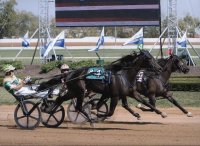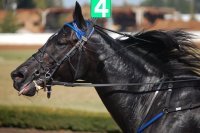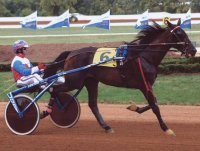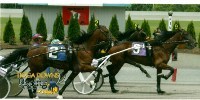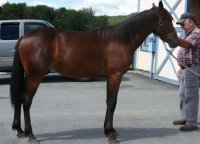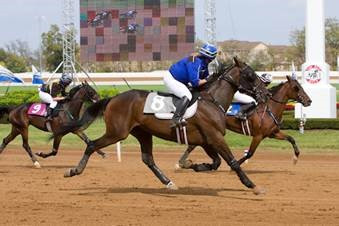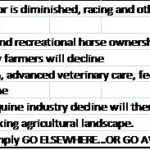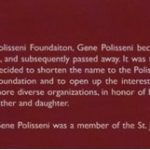Blog
Prix d’Amerique Weekend Showcases Monte
The January 26-27 Hippodrome Paris-Vincennes cards showcased several exciting monte events. On Prix d’Amerique day the card contained two graded monte races, the first the Grade II Prix Jacques Andrieu (Lalique) over 2,850 meters for 120,000 euros. This UET Master Series race produced a 27/1 upset winner in veteran 8 year-old mare Rive Driote (by First de Retz), ridden by Fabien Gence.
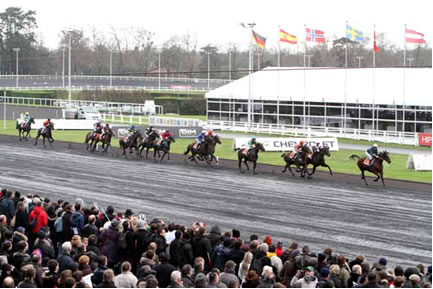
Two races later the Prix Camille Blasiot (Lenotre), also a Grade II 120,000 euro event over 2,850 meters, yielded a 5/1 winner Udo de Nieul, ridden and trained by Romain Derieux. This one is a 5 year-old stallion by Cygnus d’Odysse.
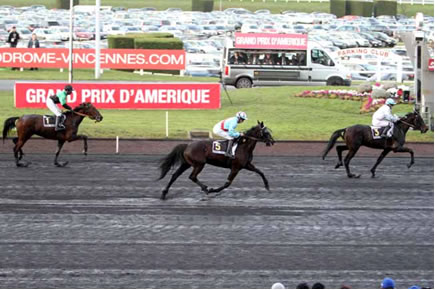
The prior day (Prix du Luxembourg Day) card included a fast class monte event, the Prix Clamecy for 68,000 euro over the 2,700 meter distance. The 38/1 upset winner, Ukepepere, is a 5 year-old by Indy de Vive (sire of Ready Cash) ridden by Ms. Amandine Brouel.

Stall Trot Inc.
Trotting – Sweden’s ‘third way’ on a racetrack

Published: 24 Nov 11 14:44 CET |
Online: http://www.thelocal.se/37548/20111124/
The popular Swedish equestrian sport of trotting reaches a hoof-thundering climax this weekend with the V75 meet at Jägersro near Malmö, Geoff Mortimore explores the sport where "lagom" really is best.
To many a newcomer in Sweden, the strange feeling of not being able to ”get” trotting (harness racing) is similar to that of being the only one in the pub who isn’t in on the joke but realising it must be funny, because everyone else is laughing.
Walk into any sports pub in Sweden and it is likely you will see someone staring up at a TV screen on the wall uttering in English, ”Why don't they just run properly?” Or something along those lines, as they consume a sport that is as deep rooted in Swedish society as football is to a Brit, or hockey to an American. The question remains though. Why?
After all this is a sport every Swede seems to know at least something about, and, even if they don’t actively participate, most still seem to have a soft spot for it, hence the entire TV channel dedicated to it, as well as prime slots on terrestrial stations.
To the uninitiated, trotting is horse racing, only with a driver in the carriage behind.
The tracks, 33 of them dotted all over the country, are testament to the popularity and the provincial nature of the sport and constitute one of the key reasons for trotting’s popularity, according to TV expert commentator Peter Andersson, a man more than happy to be labelled a ”trotting nerd”.
”Most of the tracks were built in the 70s, they are not just in big cities and they all have good facilities, making it a very comfortable pleasant day out for the family. Very civilised, very Swedish,” he smiles.
One theory about its popularity is that the racing, at what could be described as a leisurely pace, always with a sense of control and where tactics and methodology outweigh the more primitive hell-for-leather attitude of flat racing, reflects Swedes in some way. Gladiatorial it is not.
There are many theories about how it came to be a sport in the first place, but in Sweden it is generally accepted that the origins lay in the forests up north. The forestry workers cutting down the trees would then transport them on horse driven carts and race each in the process.
As this became more popular, the Swedes, ever happy to place a bet, morphed it from humble beginnings in the 1800s into a sport that is worth millions today, not least to the treasury department who take a share of the action as part of the state betting monopoly.
Of course the money aspect drives the sport as much as anything else, and it taps into the Swedish hunger for betting but with decent odds of winning, especially on the V75 weekly selection of seven races. Even when it comes to betting there is still something very "lagom" about placing money on trotting.
”I think the key thing with its popularity is that people love to bet, and with trotting, more than other forms of racing, or the lottery, you actually have quite a good chance of winning,” says Andersson.
Trotting has always been much more of a regional sport than in the cities, although the largest and most famous course is Solvalla in Stockholm, home to the biggest event on the calendar each year, Elitloppet, worth some two million kronor to the winner.
The race, one of the biggest of its kind in the world has been contested since 1952. It was also at the centre of the sport’s biggest scandal in 2006 when the best horse in the world at the time, the French trained Jag de Bellouet was disqualified having won the race after testing positive for a banned substance. Worse still, the runner up that day also tested positive.
The rules and checks have been tightened up considerably says Andersson, but the saga was still a major blow to the sport. The Elitloppet is also proof of what an international sport trotting has become. While Sweden is by far the biggest of the Nordic countries, France, Italy, the US and Canada also have regular meetings and a strong following.
If you do fancy a flutter, this weekend could be as good as any to dip your toe in the water, as the last of the year's big races takes place at the Jägersro track in Malmö.
It’s a genuine slice of Swedish life, you could end up richer, and maybe even feel that you get the "joke" after all.
Geoff Mortimore (news@thelocal.se/08 656 6518)
Queen of Western New York trotting ready to bid farewell to the racetrack
from Batavia Downs Media Relations
Batavia, NY — Tuesdays With Mom, a New York Sire Stakes champion and a top Open Trot performer, will end her racing career on Friday night (Nov. 25) at Batavia Downs Casino. The 4-year-old Credit Winner-Princess Deanna trotter is being retired so she can begin her off-track career as a broodmare. She will start from post seven in Friday's second race, the $8,100 Open Trot.
She wasn't just good, she was terrific. She won the first two starts of her career as a 2-year-old in 2009, taking NYSS events at Vernon and Buffalo Raceway. In her nine race freshman season she won six times and finished second in the other three starts. That included a runner-up finish in the NYSS Night of Champions at Vernon Downs. Her 2-year-old earnings were $187,040.
She came back even better to begin her sophomore campaign, winning at Monticello and Buffalo. She ended her 3-year-old campaign by going gate-to-wire in winning the $200,000 Night of Champions in 1:56.3 at Yonkers, with George Brennan in the sulky. For the year she would make 10 starts with seven wins and three seconds and earnings of $246,186. After two years of racing she had never raced in an overnight event and not finished worse than second.
This year her 14 starts have all come during the summer-fall meet at Batavia Downs. She has six winner's circle visits, been second three times and third twice. She heads into her final start with earnings of $33,055. “She’s simply worth more as a broodmare than as a racehorse," Arrigenna said. “I love the breeding part of the business and we plan on spending a lot of time on the road next year.”
"We have Archangel (Credit Winner-Michelles Angel) staked all over and three other 2-year-old NY bred colts that I really like, plus a Pennsylvania bred filly by Donato Hanover that we purchased at Harrisburg, so we’re going to be busy next year.”
Arrigenna's plans are to breed Tuesdays With Mom to Donato Hanover.
“I really think she’s going to be an excellent producer; we’re very excited about the future.”
Win, lose or draw, Tuesdays With Mom will return back to the winner's circle for her final time as she bids farewell, giving Western New York race fans a last look at one of the best trotting mares this circuit has ever seen.
Positive Change
Today’s Harness Racing Product Needs Positive Change
Leadership
Change is not easy, but without it keeping harness racing viable will be difficult at best and perhaps impossible. But where to start? What changes can improve the product to make it more interesting/exciting from the perspective of the bettor, novice and media? Which changes have the best chance of improving the sport’s economic viability? Which ones can be tried? What resources are required, available and how could they be employed? Priorities must be established and initiatives formulated that can be implemented (and measured) as soon as possible. Horsemen’s organizations, through stakes, breed awareness/development and people, have the best opportunity to initiate change, to lead the industry.
Let’s start with the premise that horse racing is a consumer business, and that viable products and services must be something that consumers want, need and are willing to pay for. Viable products and services need to be supplied in quantities and at venues that match demand. The key component of the standardbred industry is its racing and pari-mutuel wagering product. That’s where the focus should be and where horsemen’s organizations can initiate and implement change. Improvement requires focus, starting with product and establishment of key priorities.
Awareness, Goal Setting, Leadership
Horsemen’s association have the unique opportunity, through their respected personnel and stakes sponsorship/administration, to focus on major issues affecting harness racing in America, obtain consensus, set focused goals and initiate change. Stakes events remain the cornerstone of US harness racing and are respected, covered in the media to some degree and offered through simulcasting in North America and to many countries. These stakes showcase US racing and US horses that have positively affected standardbred development and desirability of yearlings and breeding stock here, in Europe and the Pacific Rim. What better basis to:
- Drive increased pari-mutuel handle, product interest and exposure to a broad demographic
- Produce greater competitiveness, higher odds, larger payoffs
- Generate equine icons, the stars of the sport
Horsemen’s associations are suited to embrace consistent principles, create change and promote results to all parties of interest in the industry.
Recognition that Pari-Mutuel Wagering is the Foundation of Industry Health
Recent studies conducted by Purdue University on the impact of the Indiana Horse Racing and Breeding Industry and by Rutgers University regarding New Jersey illustrate the positive economic affect of a healthy equine industry:
- In 2009 the total economic impact of the Indiana racing and breeding industry was over $1 billion, up from $294 million in 2005; in 2007 the New Jersey economic impact was $1.1 billion
- In 2009 the Indiana industry paid $69 million in state and local taxes, up from $5 million in 2005; in 2007 the New Jersey equine industry generated $160 million in federal, state and local tax revenues
- The industry generates direct and related employment of 9,865 jobs in Indiana and nearly 13,000 jobs were provided in 2007 in New Jersey (9,150 equine industry and 3,820 racetracks)
- Significant shares of racetrack revenues are derived from off-track pari-mutuel sources and much of the investment in equine breeding is from out-of-state interests, indicating that the industry is a major export industry generating in-state revenues from out-of-state sources
- Amount and nature of “real” investment spending have long-lasting economic impact; the New Jersey study suggests that the industry has over $4 billion in assets employed
The Purdue survey concludes that “from a nation-wide perspective, a racetrack is either expanding or declining…When a racetrack is successful, it can afford to offer larger purses and attract better horses and athletes, drawing in larger incomes from pari-mutuel and off-track wagering, which then affords an opportunity to offer even more attractive purses. When a racetrack is less successful, purses decline and the cycle reverses.”
The same dynamic is reflected in EPMA-Europe’s recent study on the economic and social contribution of horseracing
- European horse betting and the horse industry is large and vivid – 40,000 breeders, 300,000 jobs, 500 racecourses, 4% of land used to produce horse feed, 80,000 races annually, 170,000 race horses, 20 million betters, 35 billion euro of bets, over 1.8 billion euro paid in government taxes
- Horse racing fosters social cohesion, events of national importance, draws diversified spectators and attracts varied profiles of betters (in France 29% of betters are age 18-34 and 33% are age 35-49; 34% of betters are women; 67% began to bet through their friends or relatives who also bet; in 2009 there were 6.5 million clients/punters)
- Betting is the main component of horseracing funding; and horseracing employment is closely correlated to horse betting handle
- Horse breeding is driven by purses financed by betting (.82 correlation to number of breeders; .94 correlation to number of foals, mares and stallions)
- Countries with uniform regulation and legal frameworks prosper; those with non-uniform regulation decline; fall in pari-mutuel handle leads to decline in betting contribution to the industry, fewer industry jobs, lower purses, fewer top quality horses, decline in racing quality, and fewer betters
The Rutgers study summarized it well, for New Jersey and perhaps for the entire US equine industry:
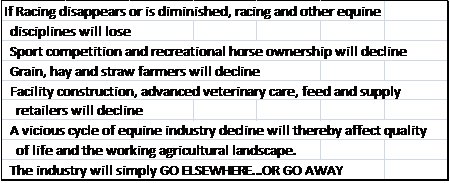

Wagering Product in the US
A review of wagering statistics in the US suggests a product that is too predictable, too uniform and perhaps uninteresting to all but professional horseplayers who utilize technology to search for wagers that it deems attractive from a return on investment standpoint. Uniformity of product and uniformity of past performance data creates a relatively easy basis for computer modeling.
Horse racing in other countries where pari-mutuel wagering remains effective, offer a far less uniform product and therefore less data regarding horse past performance. It would appear that these products offer an attractive proposition to a greater cross section of the population/demographic and can compete with lottery and other wagering forms. Some countries offer more variation in wagering options including forms of super-bets which are limited in availability to a single daily race or a single set of races on specific days that provide large pools. Certain “Super-Bets” offer automated, computer generated selections for those that want to play but not handicap (e.g., SWE’s “Harry Boy”). It would appear that a longer period from engagement to race day permits more handicapping time for these races (e.g., seven day engagement period in FR).Tracks in other countries do not have slot machines onsite although casino competition exists. The successful pari-mutuel countries do, however, have numerous off-track outlets and coordinated internet wagering vehicles.
Throughout 2011 we have sampled various harness betting statistics in the US, Canada (Woodbine) and in Europe with the findings shown below:
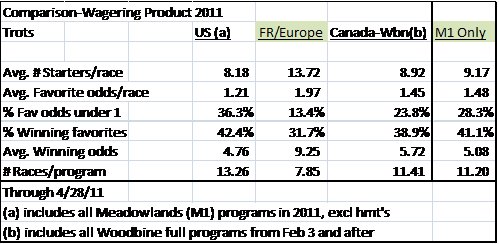
US tracks sampled do not include half-mile tracks. European tracks include major tracks in France, Belgium, Holland, Germany and Spain. Field size would seem to be a driver of higher favorite odds and lower favorite winning percentage. Other determinants may be varying distances, starting and handicap methods, track surfaces, sulky and under-saddle racing, conditions based on age, sex and lifetime earnings and even clockwise and counterclockwise direction. The European product design appears to create a fair and ethical “game of chance” that appeals to a wide audience, not just to professional handicappers. Performance enhancing medications are not permitted.
Creation of a Super Product, a “Daily Super Bet” to complement lottery and slots
A vehicle that can create pari-mutuel handle growth and exposure to the masses is the “Daily Super-Bet”. Concepts vary (Quinte+, V75, and V64) but the principles are similar:
- Limited availability (exclusive to one race/day or several races on a single day from a single racetrack)
- Available through authorized simulcast and account wagering outlets
- Generate large common pools
- Provide the probability of large payoffs, typically driven by large fields, widely dispersed odds without prohibitive favorites
- Promoted widely by betting organizers/operators and their affiliates
Largely populated states such as New York, Pennsylvania and others theoretically have the opportunity to create such bets given cooperation of racetrack operators, lottery commissions and the like. Horsemen’s associations may have the opportunity to influence the creation of these bets starting with its sponsored stakes and given changes in race conditions.
“Jackpot” bets with huge payoffs create a “game of chance”. We presently do not have an opportunity to attract anyone to bet except for the serious handicapper. “Quinte+” races in France typically generate handle in the 400,000 euro to 2 million euro range, on a single race, seemingly connecting with casual bettors. In 2009 there were 189 Quinte+ (France) payoffs of 100,000 euros or more. Another feature of these “attractive” races is that they create a lottery-like bet where takeout appears not to be a material issue. The most recent European Pari-Mutuel Association (EPMA) statistics from 2009 show that the V75 and V64 in Sweden generated 45% of its total handle. In Norway the same bets contribute 38% and in France the daily Quinte alone is 21.9% of its 9.3 billion euro revenue. Further, PMU France revenues have grown every year from 1999-2009 and at a compounded annual growth rate of 5.5%, increasing by over 71% from the 1999 level.
Use “Daily Super-Bet” funds to seed and distribute funding to broader initiatives such as product change, organization/administration and promotion
Conceptually the distribution of “Super-Bet” takeout could generate funding for promotion of the event itself to patrons, media outlets, sponsors and even equine industry entities excluding the horseracing segment. The “Super-Bet” could, if successful, be the driver of expanded change to the racing and wagering product, organizational uniformity and continuous expanded promotion.
Horsemen’s Associations as Role Model, as Change Agent
Conditions change could enhance the stake race relevance and exposure. Changes could become the basis for expanded stakes change in the areas of eliminations, field size, post position draw, distance, purse distribution, purse enhancement based on fan attendance. There may be opportunity to merge or expand race conditions based on age and sex, thereby encouraging leading horses to remain active longer, and perhaps be used for both racing and breeding. Examples could include open events for three year-olds and up (horses and mares).
Through stakes, horsemen’s organizations can influence investment, owner/fan development, types of bets on its events, scheduling to maximize simulcasting and broadcast coverage, and attracting greater attendance/social interaction. By exerting control over stakes events these organizations can and should become the chief advocates of US harness racing.


NJ Governor Christie Letter
August 1, 2010
State of New Jersey
Office of the Governor
P.O. 001
Trenton, NJ 08625
Tel: 609-292-6000
Dear Governor Christie:
On behalf of harness racing interests globally we would like to point out the facts about the economic “multiplier” of horse racing, and ask that you put aside politics, special interests and lobbyists influence and do the right thing for your state and its equine participants.
For over 30 years, since the creation of The Meadowlands Racetrack, New Jersey has held a place of prominence in the equine industry, especially standardbred, due to its strategic location, facilities, mile-track racing and a then management that understood the business and was able to attract the best horses, stables, owners and patrons. The Meadowlands became the “image of harness racing” in North America and attracted respect of harness racing industries in Europe and the Pacific Rim. That “exposure” allowed US breeders to sell standardbreds for export and to utilize some of its prized stallions during the US off-season in Australia and New Zealand. These activities generated taxable income for US domiciled persons and entities. When The Meadowlands became the home and host of the fabled Hambletonian its reputation was further enhanced and The Meadowlands established an impressive array of stakes events for trotters and pacers that benefitted both racing and horse breeding participants. Technology advancements have also enabled New Jersey based breeding farms and their stallions to breed mares worldwide using frozen semen, further enhancing the reputation of US standardbreds.
Equally important is the aforementioned multiplier effect that the equine industry contributes to the New Jersey economy:
- Tax revenues –real and personal property, pari-mutuel, sales and employment taxes
- Employment directly and indirectly in the horse industry
- Taxable income to providers of ancillary services – veterinarian services, feed, tack, equipment and apparel, equine related construction, breeding and turnout farms, training centers, shipping companies, operators of yearling and mixed horse sales, lodging, food and beverage
- Source of highly sought after simulcast signals to capture market share of out-of-state pari-mutual bettors
- Maintains and enriches green space that is productive green space
- Brings participants and tourists to the state
- Provides broadcast and news coverage for the state relating to major events such as the Hambletonian, Nat Ray, Peter Haughton Memorial and others (just as NFL football, MLB and NBA basketball provide to the NJ and metro NYC area)
A recent Rutgers University Equine Science Center report supports that position clearly
“The New Jersey equine industry is valued at $4 billion and generates $1.1 billion ($780 million due to racing) annually in positive impact on the state economy. It is responsible for 13,000 jobs, more than half of which are generated by racing-related interests such as race tracks and horse breeding and training facilities. The New Jersey equine industry pays an estimated $160 million annually in federal, state, and local taxes ($85 million generated by equine operations and owners and $75 million generated by New Jersey racetracks).
A total of 176,000 total acres support equine facilities in New Jersey. Approximately 96,000 of these acres are directly related to equine activities, 78,000 are devoted to pasture and hay production, with 46,000 additional acres producing hay and forage on non-equine-related operations. Equine-related acres represent more than one-fifth of the state’s 790,000 acres in agriculture. Equine animals and operations account for 42,500 horses housed in New Jersey at 7,200 facilities. Of this total, 12,500 (nearly 30 percent) are in racing-related activities. These include 8,200 Standardbreds and 4,300 Thoroughbreds (on a total of 700 facilities) that are either actively racing or are racing breeding stock.
The Garden State stands to lose the greatest portion of its premier agribusiness that generates $780 million of economic impact annually, 7,000 jobs, $115 million in federal, state and local taxes, and 57,000 acres of working agricultural landscape and open space, if racing-related training and breeding farms leave New Jersey. Contributing to the total economic impact are New Jersey’s four racing venues: the Meadowlands, Freehold Raceway, Monmouth Park Racetrack, and Atlantic City Race Course, valued at $502 million annually.”
We suggest that you view the facts, in an unbiased manner, and make decisions regarding the equine industry that make sense, that consider sustainable economic impact in New Jersey, that value jobs and related equine service revenues and reflects that equine models do work effectively elsewhere (France, UK, Ireland, Sweden, Norway, Finland, Australia, New Zealand, Japan). Do your homework thoroughly, learn and act favorably for the equine industry and for your state.
Sincerely yours,
Stall Trot. Inc.
Attachment
European Pari-Mutuel Association Annual Report
http://www.parimutuel-europe.org/Download/2010-06/EPMA_ActivityReport_2009_2010.pdf
Pari-Mutuel Wagering, Updated
A number of recent developments have continued our focus on pari-mutuel wagering as a driver of the sustainability of the North American Horse Industry. P-M wagering is in the control of the industry that it supports, to a significant degree, and its longstanding link to horse racing fosters a connection that slots/alternative gaming cannot achieve. Successful pari-mutuel wagering, like many businesses, requires the effective combination of key success factors and management’s consistent and diligent commitment to operational and strategic excellence:
- Desirable product and venues
- Ethics/Integrity, a level playing field
- Superb customer service and amenities
- Social interaction on-site and online
- Effective promotion of the total entertainment offering, as “the place to be and to be seen”
- Appeal to a broad demographic audience
- Fair value
Recent major horse racing events indicate that fans continue to embrace the sport/industry and the best it has to offer. The Elitloppet, Epson Derby, Belmont Stakes and before that the Prix d’Amerique, Preakness and Kentucky Derby signal that the sport is not dead. This past weekend the Canada Equine Expo at Guelph combined an educational and product/service offering to equestrian participants of all types and breeds, reflective of the horse industry’s breadth and employment opportunities. Additionally, despite global economic woes 2009, “turnover” at PMU-France and ATG-Sweden posted increases over 2008, with each having large pool wagering opportunities named the “Quinte” and V75/V64. These bets are daily (a single race) or weekly (Wednesday and Saturday), respectively. A menu of more traditional bets is offered at operating tracks on a daily basis. Both PMU and ATG operate many off-track wagering outlets (over 2,000 in each country) along with their online and account wagering networks. ATG offers a system generated betting option for those punters not interested in doing their own handicapping.
Just last weekend a first large pool pick-6 wager was offered in the US, aptly named the “Metro 6 Shooter” to reflect the partnership of Yonkers Raceway and The Meadowlands in that endeavor with a guaranteed $30,000 pool add-on. That’s a start, but what it will take to rival FR and SWE is a national wager offering on-track, online and account wagering wagers into a single pool that will be so large as to warrant national fan, media and widespread broadcast attention. P-M wagering on an excellent product can save the horse industry from single-minded dependence on alternative gaming and over-saturation of a product that can be viewed by some as a commodity.
The sections below illustrate the opportunity and challenges facing all participants in the horse industry. The industry must focus, must unite and must force its so-called breed registries to do their most important job….to advocate, promote and lobby for change that positively affects the sustainable economic impacts of the horse industry.
Elitloppet at Solvalla
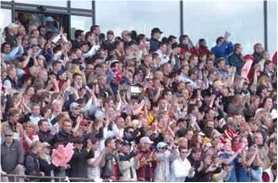
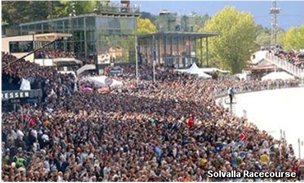

http://www.youtube.com/watch?v=wM5H-RB4FeA
http://www.youtube.com/watch?v=EHAsJXeW0ik&feature=related
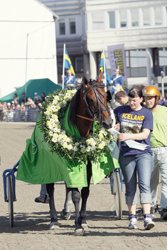 ICELAND Erupts in the Elitloppet
ICELAND Erupts in the Elitloppet
Tuesday, 01 June 2010 12:08
ICELAND was crowned in Sunday’s Elitloppet in Sweden. © Daniel Palmeri / racingpix.co.uk
After a third place in his qualifying heat, Iceland (Johnny Takter) won the final of the 2010 Elitloppet (Gr.1 International) held at Solvalla, Sweden. When the mobile gate released the field, Scarlet Knight‘s son took the lead with one of the favourites, Brioni (Joakim Lövgren) following him on the inside. The rhythm was rather slow in the first part of the mile race, as the leaders covered the first 500 metres in 1’11″2 km rate (1:54.3 mile rate) only. In the last turn, Iceland still had the lead and flew-off for an easy win covering the mile in 1’10″5 km rate (1:53.2 mile rate).
“This is fantastic!” said trainer Stefan Melander after Sweden’s greatest harness-racing event. Indeed, Melander won the Hambletonian in the United-States with Iceland‘s sire, Scarlet Night, and to see his son win the Elitloppet was probably the best experience ever. “Iceland is a copy of his sire, the only difference is his ability to start a lot faster,” said a delighted Stefan Melander.
Örjan Kihlström steered Iceland to third place in the qualifying race, but decided to drive Triton Sund in the final, leaving his seat to reinsman, Johnny Takter. “I am very grateful that I got this chance to race for Stefan,” said Takter. “There are many drivers who are queuing-up to drive this kind of horse. It felt good when we got to the line and I had a good feeling throughout the race,” he concluded.

Prince de Montfort Beats World Record on Elitloppet Card
Sébastien Guarato’s Prince de Montfort is the fastest French trotter under saddle in the world! With Antoine Wiels on his back, he covered the mile at Solvalla, today, Sunday, in 1’10″5 km rate (1:53.2 mile rate). He broke the previous record held by Malakite who covered 2,175 metres in 1’10″8 at Vincennes, France. However, Malakite‘s record was obtained with a standing start and on a longer distance.
Epsom Derby

The Epsom Derby, which is attended by the Queen, is the largest annual gathering of people in Surrey. The event was attended by more than 100,000 race-goers. Workforce storms to victory in the Derby at Epsom
Workforce broke the track record with a blistering turn of foot as he won the 231st running of the Derby by seven lengths at Epsom. The breathtaking victory in baking sunshine sealed a Classic double for champion jockey Ryan Moore after his Oaks win on Snow Fairy. It was the fifth victory in the race for Newmarket trainer Sir Michael Stoute as Workforce finished ahead of 100-1 shot At First Sight with Frankie Dettori third on 9-2 chance Rewilding.
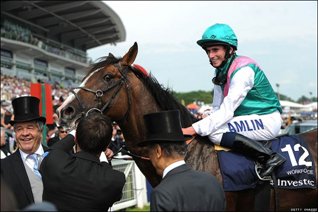

Belmont Stakes
Drosselmeyer surprises in Belmont; wins the $1 million Belmont Stakes
An underachiever finally came through in the $1 million Belmont Stakes and gave Hall of Famers Bill Mott and Mike Smith milestones they’ve been seeking for decades. Drosselmeyer, left out of the Kentucky Derby because he failed to earn enough money, outlasted a couple of Dudes and held off Fly Down by three-quarters of a length to win the final leg of the Triple Crown. On a hot, sunny Saturday in front of 45,243 at Belmont Park, Drosselmeyer was sent off at odds of 13-1. It was Smith who made a key decision to keep his long-striding colt in the clear. He eased the horse to the outside for the run down the backstretch, always keeping First Dude within range. Drosselmeyer made a five wide move on the final turn and continued widest of all, eventually reeling in Game on Dude, then First Dude before holding off a late charge from Fly Down.
Metro 6 Shooter – First Metro 6 Shooter Pays $43,181
The Metro 6 Shooter, a pick six wager comprised of races from the Meadowlands and Yonkers, returned a hefty $43,000 payoff in its first week. The winning sequence (1-9-4-3-2-8) returned $43,181, while the five-of-six consolation paid $232. The Metro 6 Shooter began with $30,000 added to the net pool, while another $34,476 was wagered into the pool. The Metro 6 Shooter returns next Saturday with another $30,000 being added to the net pool before wagering. A $1 minimum wager, the Metro 6 Shooter begins in the fourth race from the Meadowlands each week. Free Platinum Past Performances and selections for the Metro 6 Shooter are available each from TrackMaster at www.Trackmaster.com/metro6.
Odds Analysis
This past weekend’s analyzed major tracks’ actual odds and winning favorites suggests the negative effect of owner, trainer, driver consolidation and race conditions that encourage dominant betting favorites in North America. Further, the high percentage of winning favorites in North America also discourages punters looking to defeat the overwhelming choice. Many may opt not to play, or to go elsewhere where the risk/reward ratio is more favorable. The current results mirror that of studies we performed in February and March 2010 albeit the percent of winning favorites in North America has risen. Unless this matter is resolved, look for continuing P-M wagering declines, track closures and movement of wagering elsewhere to larger pools and more competitive conditions. Note that despite global economic recession, 2009 P-M turnover increased at PMU France and ATG Sweden over the prior year. There must be unified “urgency” versus discussions of music to stir the fans hearts. There is no single easy fix.

Canada Equine Expo
The annual Equine Expo, held June 4-7 at Guelph, illustrates the widespread economic multiplier of the horse industry and demonstrates its worth preserving and growing for social, environmental, employment and governmental tax revenue reasons.
“Canada has great equine and equestrian resources. We’re pleased to
offer an event that focuses on the science of horse care and training.”
Brian Kitchen – Director of Business Development & Livestock, Canada’s Outdoor Shows Limited
http://www.equineexpo.ca/pdf/2010-PromoBrochure.pdf
Ohio’s Plight Mirrors KY, IL, MI, NH, MA, CA
Ohio Horsemen meet with Governor
Sunday, June 06, 2010 – by T.J. Burkett, managing editor, Hoof Beats
Nearly 400 concerned horsemen from both the Standardbred and Thoroughbred racing communities gathered Sunday night (June 6) to meet Ohio Gov. Ted Strickland and reiterate their collective desire for alternative gaming at the state’s seven racetracks. Strickland had previously gathered favor from horsemen’s groups when, last July, he ordered the installation of VLTs at racetracks as a way to alleviate the state’s budget woes. Since then, his plan has run into several obstacles, including the passage of a constitutional amendment allowing four free-standing casinos, and most recently, a referendum this coming November that will require voters to decide whether or not to allow the terminals at tracks. Strickland has been steadfast in his decision, despite the political heat that he has endured.
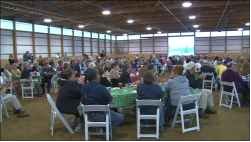 Nearly 400 Standardbred and Thoroughbred horsemen met to hear Gov. Strickland speak.
Nearly 400 Standardbred and Thoroughbred horsemen met to hear Gov. Strickland speak.
Lottery Commission Objections; Strong P-M Competes with Government Run Gaming
CPMA Nixed ‘Million Dollar’ Idea

The Canadian Pari-Mutuel Agency (CPMA) is a roadblock preventing the harness racing industry from developing the new and innovative betting products it needs to survive. And it’s up to the racing industry to do something about it. That was the message delivered by Ted Smith during a standardbred industry panel discussion at the inaugural Canada’s Outdoor Equine Expo in Arkell, Ontario yesterday.
Just a week after retiring from his 34-year tenure at the Canadian Trotting Association, Canadian Standardbred Horse Society and Standardbred Canada, the former President and Chief Executive Officer dumped a truckload of blame for racing’s betting woes at the doorstep of the CPMA. “Right now, the Ontario provincial lotteries, our biggest competitors, can change a game in 30 days and implement. But it takes four years to change pari-mutuel regulations,” said Smith.
Smith said Standardbred Canada has a team of young, eager people looking for new and innovative ways for racing to better compete against ever-expanding lotteries and gaming, but the door is being slammed shut by the CPMA, the federal government agency that regulates and supervises pari-mutuel betting on horse racing at racetracks across Canada. “The last time Standardbred Canada proposed new regulations, we didn’t even get a letter back from the CPMA,” said Smith. “Not even the courtesy of a phone call.”
Smith noted Standardbred Canada is not the only industry stakeholder frustrated with the agency. He told the meeting that the Woodbine Entertainment Group and the Score television network hatched an idea to re-launch its Monday night national TV broadcast as “Million Dollar Mondays” and give horseplayers a chance to win $1 million if they could pick all the winners on the Monday card. “We would have had people from all over North America watching, but the CPMA nixed it in two minutes. They said it’s not going to happen.”
Smith said it’s now up to the horse racing industry to change the CPMA. He believes the slots revenue era has led to industry complacency and that has to change. “There is a sense of self satisfaction from the participants. But if we don’t build up betting again, we’re going to be in trouble. “We need to lobby for change. The industry has to be united, have one united position and take it forward,” said Smith who feels conflict between horseman and racetracks has to end.
To make change happen, Smith said the industry must set its sights on Ottawa. With a minority government in power, he feels federal politicians will be willing to listen to the industry’s concerns. “We should be registered lobbyists down in Ottawa,” said Smith. “The industry really has not pursued the CPMA. It’s on our shoulders to do that and move forward.” Smith, for one, says he’s up to the task. “I have a bit more time on my hands now and I’m going to work toward that.”
Stall Trot Supports NY Horse Industry
Recent NY legislative initiatives aimed to salvage the broken NYC OTB and strip funds from NY Sires Stakes programs have elicited response from responsible breeders and owners from throughout North America, including our organization, that support the NY program.
Dear Senator Adams:
Our organization and the families of its owners have bred, owned and raced NY bred standardbred horses for over 60 years. We understand the enormous economic “multiplier affect” that our horse industry ( standardbred and thoroughbred) contributes to NYS, specifically in the support of breeding farms, racetracks, support services such as hay and grain farmers, veterinary services, blacksmith services and universities; employment of thousands of tax-paying people throughout the state, horse sales conducted at Morrisville College and by thoroughbred sale companies in Saratoga and maintenance of thousands of green-space acres.
Unfortunately, the longstanding poorly run OTB operations have not represented the industry and its patrons effectively. I have visited several, as recently as last week, and they continue to be an embarrassment to the horse industry, its tradition, culture and attractiveness as a wagering alternative. NYC OTB and in fact statewide OTB should be totally reorganized and embodied in a non-profit corporation operated by representatives of the NY Dept. of Agriculture and the horse industry participants, including track operators. Other states (and other countries) have vibrant OTB operations that contribute to pari-mutual wagering consistent growth in countries such as France, Sweden and Norway. We suggest that you allow NYC OTB to perish, and move on with the non-for-profit structure that we believe will better benefit the state, its horse and agricultural industry and its voters. Do the right thing for an important segment of the NYS economy.
Likewise we suggest that you strongly oppose Gov. Patterson’s proposed cut to NY standardbred breeders funding by 48%. Coupled with the OTB wreckage this would lower the NY program from its current $16mm, a level still below that of PA, IN and Ontario, to about $7mm according to Harness Horse Breeders of New York State. At the lower level the NY program would no longer be competitive and would result in the closure of breeding farms, movement of stallions and broodmares to more lucrative states and to Ontario. This would result to lower employment, lower tax revenues and further exodus of working people from NY. As a mid-size breeder of quality trotters I can assure you we would move our operation out of the state and we would do so starting in 2010.
Again, we urge you to support jobs, retain an important industry segment, and place organizations responsible for pari-mutuel wagering in the hands of knowledgeable, ethical businesspeople with industry related experience for the benefit of customers, the state and the horse/agriculture industry. Thank you in advance for your consideration and support.
Stall Trot, Inc.
www.stalltrot.com
The Horse Industry is its People
Recently St. John Fisher College (Rochester, N.Y.) unveiled a new era in its development with the announcement of the Polisseni Track and Field Complex. The result of a $3 million donation from the Polisseni Foundation the complex will include a 400 meter track with grass infield for shot put, pole vault and long jump events along with locker rooms for student athletes, a 1,000 seat capacity grandstand and public restrooms. Further, the state-of-the art facility will permit Fisher to add seven NCAA Division III sports to its intercollegiate offering. Construction will begin in fall 2010 and be completed in time for Buffalo Bills NFL training camp in 2011. The Polisseni Foundation gift is the third largest in school history.
Racing is not new to the Polisseni family which many of you know as Purple Haze Stable, a longstanding and successful developer of New York and Grand Circuit standardbred stakes horses with trainer Howard Okusko Jr. What some don’t know is the history of the Polisseni Foundation, its dedication and financial support to charitable causes, students’ scholarships and to Fisher at which Wanda Polisseni serves as a board member.

As the Fisher “Collegium” magazine aptly describes, the investment in student life and community by the Polisseni Foundation is “On Track”.
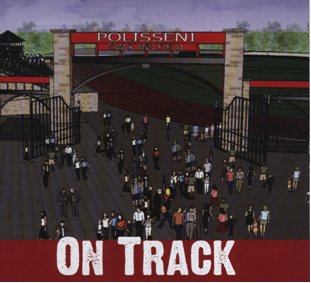
Brooks Updates (3-15-10)
Recently news regarding the Brooks matter (suspensions, related litigation and actions by trade organizations/breed registry organizations) has been minimal. The latest news reported by Standardbred Canada is shown below.
More Wild Allegations In Brooks Trial
On Tuesday, March 9 in Central Islip, New York, there was more damaging testimony in the trial of ex-standardbred horse owner David Brooks, who is alleged to have erroneously inflated the worth of his bulletproof vest company, DHB Industries, in a ‘pump-and-dump’ scenario before personally cashing out to the tune of $185 million.
According to a report on newsday.com, former DHB Industries chief financial officer Dawn Schlegel has testified that Brooks directed her to issue company cheques for as much as $9,000 in cash to pay for prostitutes. The report states that, according to Schlegel, Brooks openly admitted to his bankers that such payments were used to pay for hookers. According to the article, the amount of money spent on the prostitutes was in the tens of thousands. The report also states that Brooks had a tent set up at a company party in Florida, and that prostitutes were in the tent. According to Schlegel, Brooks told her that her employees were welcome to participate in sexual conduct with the hookers in the tent. The article also stated that Schlegel said that the prostitute issue was discussed during DHB board meetings, yet any reference to the discussion was left off the official minutes. Schlegel also testified that at one point Brooks gave her confirmation that the money was indeed going towards prostitutes by getting one of DHB’s stockbrokers to describe an instance he had with one of the prostitutes.
In addition to the prostitute issue, Schlegel also testified that David Brooks personally obtained $2,500 a week via payments from the DHB Industries-owned company Tactical Armor Products. According to Schlegel, the $2,500-a-week payments were reportedly for a fictitious loan.
More Testimony At Brooks Trial
The most recent report from the ongoing trial of ex-standardbred horse owner David Brooks outlines alleged schemes which saw him benefit financially from his company. Books is on trial in Central Islip,
New York for having allegedly falsely inflated the worth of his bulletproof vest company, DHB Industries, in a ‘pump-and-dump’ scenario before personally cashing out to the tune of $185 million. Newsday.com has reported that Dawn Schlegel, the former Chief Financial Officer for Brooks’ DHB Industries, has testified that Brooks had the company pay for numerous seats for various events at Madison Square Garden. In turn, Brooks is alleged to have sold the tickets and pocketed the cash. According to the report, Schlegel also testified regarding personal expenses that Brooks billed to the company. The report refers a luxury box at MSG, a set of fine china in the six-figure range, and tuition that was paid for one of Brooks’ daughters to attend an Atlanta university. The article goes on to state that Schlegel has also testified regarding DHB Industries’ ex-Chief Operating Officer Sandra Hatfield, who is also on trial. Schlegel is reported to have testified that Hatfield received $600,000 to buy a Florida condominium. She also testified that Hatfield’s son received $95,000 for apparent legal work, and that her husband received tens of thousands of dollars for legal work, yet Schlegel never saw any invoices.
ORC Approves Transfers From Bulletproof
Trot Insider has learned that three horses are among the first approved transfers from Bulletproof Enterprises. As per the January 28, 2010 Notice to the Industry issued by Executive Director John Blakney, one of the conditions of the immediate suspension was that any horse owned by Perfect World Enterprises, Bulletproof Enterprises. Goldfinger Enterprises, Seize the Day Industries & VAE LLC" cannot be transferred to new ownership without the written permission of the ORC.
On February 1, the ORC formed a panel of three Judges – Senior Judge Patricia Webb, William Maertens & Brian Newton to deal with all ownership transfer requests. All prospective owners must provide a written request to the ORC for permission to purchase any suspended horses to be eligible to race in Ontario. The panel of Judges created a five-page questionnaire that all prospective buyers must answer. The panel also developed a "Statutory Declaration for transfer of ownership from a suspended standardbred owner" that is sent to each applicant and must be filled out, witnessed and sent back to the panel for review. The panel of Judges will conduct a due diligence on each request. After going through what is tantamount to a screening process, the panel will make a decision to either approve or deny the request.
The next step is for the buyer to have the hard card registrations, signed by the owner, delivered to the panel of Judges along with a photo copy of a certified check or bank draft payable to the registered owner – in this case Bulletproof Enterprises.
Finally, if the request is approved, the panel of Judges will write a ruling "Ownership Transfer Approved" and deliver this ruling along with the registration papers to Standardbred Canada’s Registrar Pat Kennedy. If the request is denied a ruling will also be written "Ownership Transfer Denied." Locke sent his request for permission to purchase three horses – Amazon Art, Power Off and Waffles And Cream – from Bulletproof Enterprises to the ORC on February 3. After completing all requirements, permission was granted on February 25.
Meaulnes du Corta Wins Grand Critérium de Vitesse des Casinos de Monte Carlo Again.
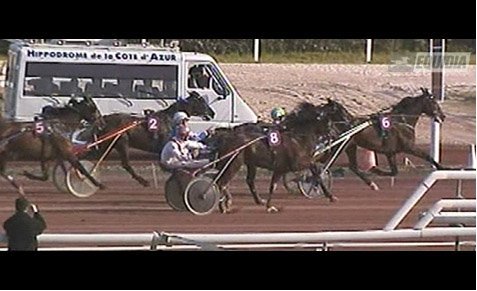
|
2010 Meaulnes du Corta – Pierre Levesque, 1.11.0a.
2009 Meaulnes du Corta – Pierre Levesque, 1.11,2a.
2008 Opal Viking – Jorma Kontio, 1.11,1a.
2007 Kesaco Phedo – Jean Michel Bazire, 1.10,7a.
2006 Kazire de Guez – Jean-Michel Bazire, 1.11,3a.
2005 Västerbo Daylight – Åke Svanstedt, 1.10,5a.
2004 Kesaco Phedo – Jean Michel Bazire, 1.09,8a.
2003 Gigant Neo – Jean Michel Bazire, 1.13,2a.
2002 Varenne – Giampaolo Minnucci, 1.09,6a.
2001 Gobernador – Dominiek Locqueneux, 1.11,0a.
2000 Moni Maker – Jimmy Takter, 1.10,5a.

